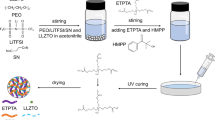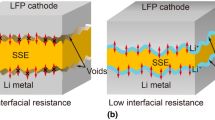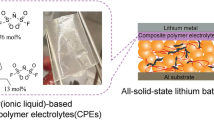Abstract
The solid-state electrolyte (SSE) has promising applications in next-generation lithium (Li) metal batteries (LMBs) because of its significantly enhanced safety and more compatible interface characteristics than flammable traditional liquid electrolytes. However, only a few attempts have achieved high-performance high-voltage LMBs, which is attributed to the fact that both high ionic conductivity and good compatibility with electrodes can hardly be achieved simultaneously. Herein, a composite solid-state electrolyte (CSE) based on star-shaped siloxane-based polymer electrolyte coupled with Li6.75La3Zr1.75Ta0.25O12 (LLZTO) ceramic fillers is designed and prepared through a facile in-situ polymerization method. The obtained CSE exhibits high ionic conductivity (i.e., 1.68 × 10−4 S cm−1 at a temperature of 60 °C), superior anodic stability, and high Li-ion transference number (i.e., 0.53) because of the multifunctional synergistic effect of the polymer electrolyte with LLZTO ceramic fillers. Moreover, the as-developed CSE shows excellent compatibility with Li anodes. As a result, the as-developed CSE enables the development of long-life 4.4-V-class solid-state LMBs with a LiCoO2 cathode, with 79.7% capacity retention and 99.74% average Coulombic efficiency after 500 cycles at a 0.5 C rate. Postmortem analysis of cycled batteries confirms that such superior battery performance can be mainly ascribed to the formation of a compatible electrode/electrolyte interface. Furthermore, excellent safety features can be observed in LiCoO2/Li pouch batteries. This work provides an important guide for the rational design of SSEs for high-voltage LMBs.

Similar content being viewed by others
References
Jiao S, Ren X, Cao R, Engelhard MH, Liu Y, Hu D, Mei D, Zheng J, Zhao W, Li Q, Liu N, Adams BD, Ma C, Liu J, Zhang JG, Xu W. Nat Energy, 2018, 3: 739–746
Zhao CZ, Duan H, Huang JQ, Zhang J, Zhang Q, Guo YG, Wan LJ. Sci China Chem, 2019, 62: 1286–1299
Xiao Y, Xu R, Yan C, Liang Y, Ding JF, Huang JQ. Sci Bull, 2020, 65: 909–916
Lv Z, Zhou Q, Zhang S, Dong S, Wang Q, Huang L, Chen K, Cui G. Energy Storage Mater, 2021, 37: 215–223
Han X, Gong Y, Fu KK, He X, Hitz GT, Dai J, Pearse A, Liu B, Wang H, Rubloff G, Mo Y, Thangadurai V, Wachsman ED, Hu L. Nat Mater, 2017, 16: 572–579
Zeng XX, Yin YX, Li NW, Du WC, Guo YG, Wan LJ. J Am Chem Soc, 2016, 138: 15825–15828
Tan SJ, Zeng XX, Ma Q, Wu XW, Guo YG. Electrochem Energy Rev, 2018, 1: 113–138
Zhao CZ, Zhang XQ, Cheng XB, Zhang R, Xu R, Chen PY, Peng HJ, Huang JQ, Zhang Q. Proc Natl Acad Sci USA, 2017, 114: 11069–11074
Huo H, Chen Y, Luo J, Yang X, Guo X, Sun X. Adv Energy Mater, 2019, 9: 1804004
Bae J, Li Y, Zhang J, Zhou X, Zhao F, Shi Y, Goodenough JB, Yu G. Angew Chem Int Ed, 2018, 57: 2096–2100
Huo H, Zhao N, Sun J, Du F, Li Y, Guo X. J Power Sources, 2017, 372: 1–7
Wang Q, Zhang H, Cui Z, Zhou Q, Shangguan X, Tian S, Zhou X, Cui G. Energy Storage Mater, 2019, 23: 466–490
Dong Z, Wei J, Yue H, Zhang K, Wang L, Li X, Zhang Z, Yang W, Yang S. J Colloid Interface Sci, 2021, 595: 35–42
Xue Z, He D, Xie X. J Mater Chem A, 2015, 3: 19218–19253
Zhou D, He YB, Liu R, Liu M, Du H, Li B, Cai Q, Yang QH, Kang F. Adv Energy Mater, 2015, 5: 1500353
Zhou D, Tkacheva A, Tang X, Sun B, Shanmukaraj D, Li P, Zhang F, Armand M, Wang G. Angew Chem Int Ed, 2019, 58: 6001–6006
Zhao Q, Liu X, Stalin S, Khan K, Archer LA. Nat Energy, 2019, 4: 365–373
Wang Y, Ju J, Dong S, Yan Y, Jiang F, Cui L, Wang Q, Han X, Cui G. Adv Funct Mater, 2021, 31: 2101523
Yan Y, Ju J, Dong S, Wang Y, Huang L, Cui L, Jiang F, Wang Q, Zhang Y, Cui G. Adv Sci, 2021, 8: 2003887
Quartarone E, Mustarelli P. Chem Soc Rev, 2011, 40: 2525–2540
Aldalur I, Martinez-Ibañez M, Piszcz M, Rodriguez-Martinez LM, Zhang H, Armand M. J Power Sources, 2018, 383: 144–149
Liu W, Liu N, Sun J, Hsu PC, Li Y, Lee HW, Cui Y. Nano Lett, 2015, 15: 2740–2745
Zhang J, Zhao N, Zhang M, Li Y, Chu PK, Guo X, Di Z, Wang X, Li H. Nano Energy, 2016, 28: 447–454
Zhou Q, Ma J, Dong S, Li X, Cui G. Adv Mater, 2019, 31: 1902029
Park C, Kim DW, Prakash J, Sun YK. Solid State Ion, 2003, 159:111–119
Liu W, Lin D, Sun J, Zhou G, Cui Y. ACS Nano, 2016, 10: 11407–11413
Han JG, Lee JB, Cha A, Lee TK, Cho W, Chae S, Kang SJ, Kwak SK, Cho J, Hong SY, Choi NS. Energy Environ Sci, 2018, 11: 1552–1562
Eshetu GG, Diemant T, Grugeon S, Behm RJ, Laruelle S, Armand M, Passerini S. ACS Appl Mater Interfaces, 2016, 8: 16087–16100
Liang JY, Zhang XD, Zeng XX, Yan M, Yin YX, Xin S, Wang WP, Wu XW, Shi JL, Wan LJ, Guo YG. Angew Chem Int Ed, 2020, 59: 6585–6589
Feng X, Ren D, He X, Ouyang M. Joule, 2020, 4: 743–770
Acknowledgements
This work was supported by the Strategic Priority Research Program of the Chinese Academy of Sciences (XDA21070304), the National Natural Science Foundation of China (51502319, 51803230, 52003285, 21901248), the Natural Science Foundation of Shandong Province (ZR2021QE039, ZR2021QE149, ZR2020MB082), the Key Scientific and Technological Innovation Project of Shandong (2020CXGC010401), and the Taishan Scholars of Shandong Province (ts201511063).
Author information
Authors and Affiliations
Corresponding authors
Ethics declarations
Conflict of interest The authors declare no conflict of interest.
Additional information
Supporting information The supporting information is available online at http://chem.scichina.com and http://link.springer.com/journal/11426. The supporting materials are published as submitted, without typesetting or editing. The responsibility for scientific accuracy and content remains entirely with the authors.
Rights and permissions
About this article
Cite this article
Wang, Q., Dong, T., Zhou, Q. et al. An in-situ generated composite solid-state electrolyte towards high-voltage lithium metal batteries. Sci. China Chem. 65, 934–942 (2022). https://doi.org/10.1007/s11426-022-1221-4
Received:
Accepted:
Published:
Issue Date:
DOI: https://doi.org/10.1007/s11426-022-1221-4




